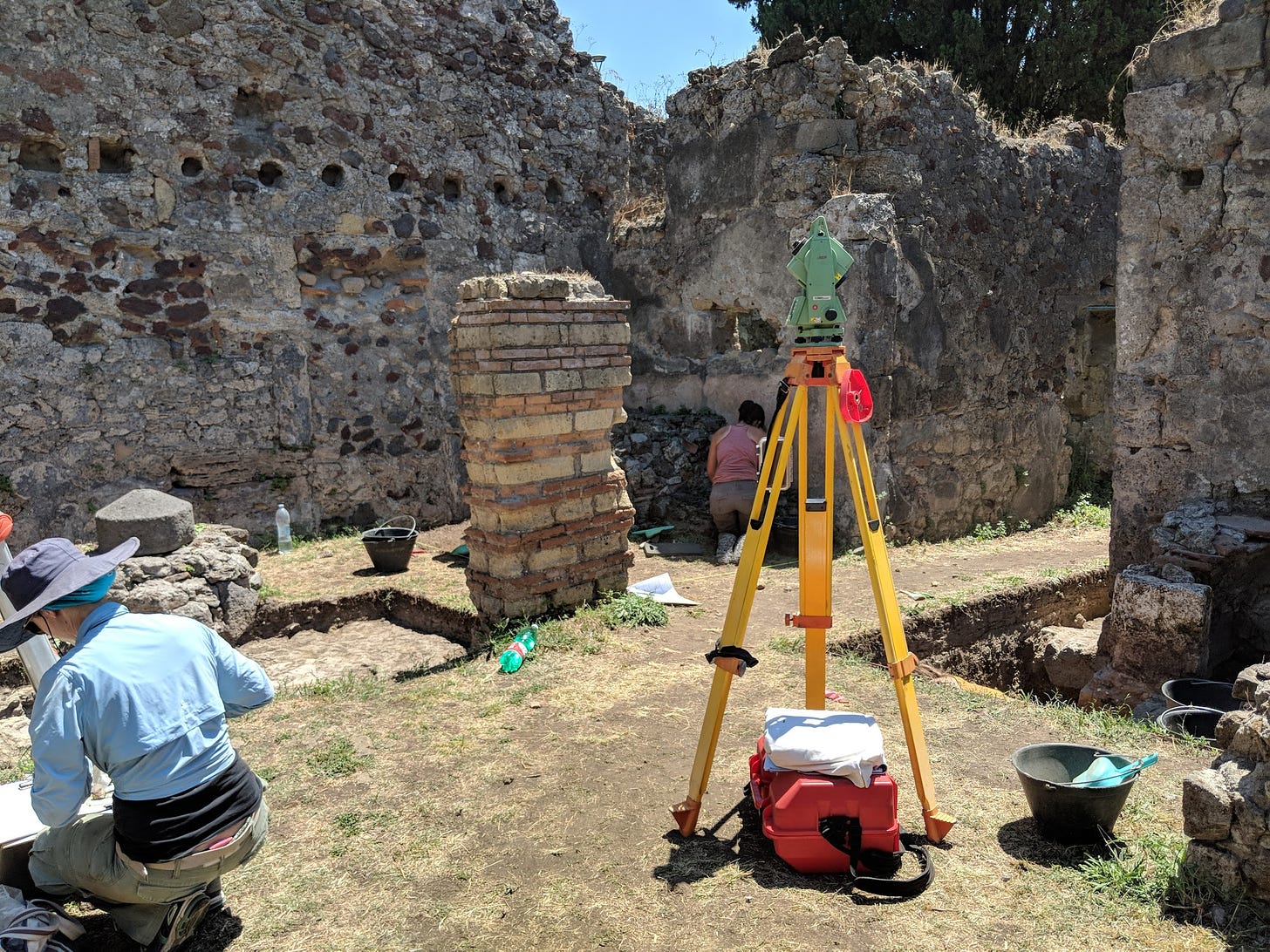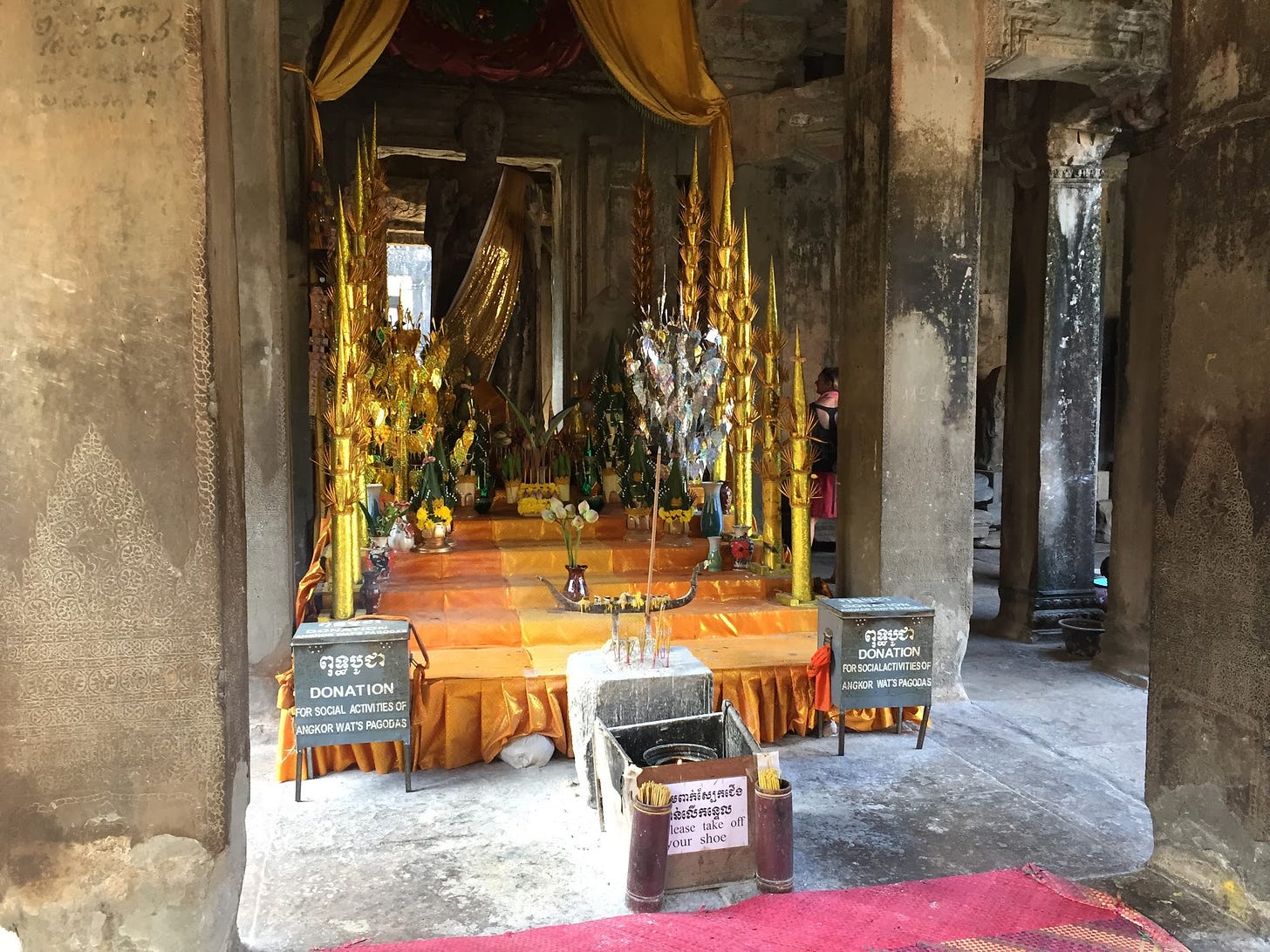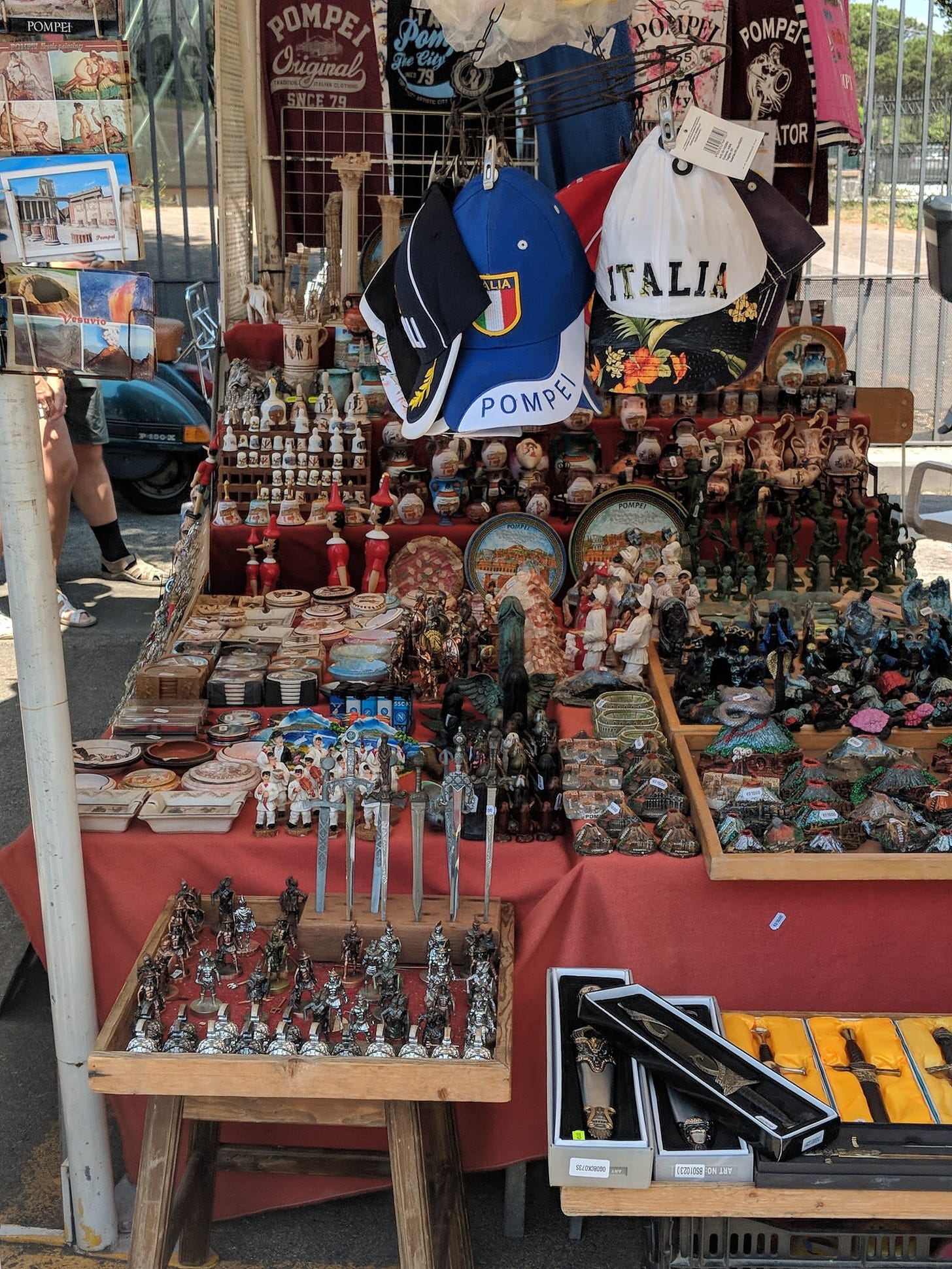Nine things to know before you visit an archaeological dig
From the importance of hats to the unresolved history of colonialism
I’ve been writing about archaeology for several years, and that often means traveling to the places where researchers are excavating. Every site has different rules, and local environmental conditions mean that people use different tools and techniques to dig. But there are a lot of other details about archaeology — and archaeologists — that you might not know. Here are a few things that I learned while writing Four Lost Cities, sometimes the hard way.
1. Be prepared to get dirty in ways you don’t expect
Most excavations involve removing dirt, mud, mold, and grime from ancient stuff -- anything from a giant wall of stone, to a tiny fragment of pottery. So you’re going to get dirty if you’re walking around looking at things. What I didn’t expect was that I would be taking off my shoes and getting my socks and feet dirty. If you’re climbing down into an excavation block where people are actively digging, you don’t want to wear your rugged boots and step on something accidentally.

Archaeologists spend a lot of time barefoot in the mud, or at least wearing slippers or sandals with very soft soles. When I was at Cahokia, an ancient indigenous city near East St. Louis, archaeologists Sarah Baires and Melissa Baltus showed me how to shovel scrape the mud to help their team excavate several structures. I wore five-finger running shoes that are actually terrible for running but great for archaeology.
2. You can still fall down a cistern, even after 2,000 years
When I visited an excavation at Pompeii, on the Bay of Naples in Rome, classicist Michael Anderson and his colleagues were excavating in a kitchen at the enormous Villa of the Mosaic Columns. The house had been plumbed, and then replumbed with fancy new first century technology, and there were at least two generations of cisterns under the floor. One of the biggest dangers of excavating at Pompeii, Anderson said, was falling into a cistern.

They’re all over the place in the city, where rich people often upgraded their houses with the latest hardware and left the old systems buried underground. Anderson warned me and my traveling companion not to step on any of the cistern covers, which my companion promptly did (she had been looking at something else, and didn’t hear his warning). It was like one of those slo-mo bits in a sitcom where everyone turned to her, their yelps of warning coming in that quarter-speed baritone “noooooooooooo!” Luckily she jumped off and it was fine, but it was definitely not a good look for the journalist at the dig site that day.
3. There are hat subcultures
When I was in central Turkey at the site of the 9,000 year-old settlement of Çatalhöyük, a group of us left a conference to tour the site in our street clothes. Archaeologist Rana Özbal immediatly reached into her purse and pulled out a tiny little pouch that had a lightweight black bucket hat rolled up inside. My suspicion is that every archaeologist is secretly carrying a shade hat with them at all times.
Archaeologists work during hot, dry seasons because you really don’t want rain to flood your excavation blocks (also, of course, academics can take summers off from teaching to do field work). This means you have to wear something on your head and neck to block the sun while you work, and it seems like every archaeological subspecialty has its own sartorial preferences. In Cambodia, archaeologists cover faces and necks with kramas, light cotton scarves with checkered patterns that are worn by the locals. At Cahokia, an indigenous city near East St. Louis, I saw mostly baseball caps worn backwards to cover the neck in the hot sun. In my experience, it’s very rare to see pith helmets or a fedora like Indiana Jones wore. It’s not about looking cool — it’s about preventing sunburn.
4. Tourists are dangerous
Almost every archaeological site of note -- especially big ones like Angkor in Cambodia, home to the famous Angkor Wat temple -- is packed with tourists wandering around right next to archaeologists. The problem is that tourists often wreck excavations by tromping around in heavy shoes. Worse, they might believe the archaeologists are digging up invaluable treasures, and come back after dark to raid the excavation. This is a huge problem at the sprawling site of Angkor, where an ancient statue from a temple can be sold for a lot of money on the antiquities market. When I visited, archaeologist Damian Evans took me to a special, guarded warehouse where researchers have put hundreds of valuable statues that were in danger of being looted from the site.

At smaller sites, archaeologists often ask me not to reveal the exact location where they’re digging. But sometimes you can’t hide. At Cahokia, archaeologists generally work in the middle of big, open fields next to a road. Sometimes passerby will pull over to see what’s happening, or to tell stories about projectile points they found nearby. A beloved local baseball player drove up in his truck when I was at Cahokia, and everyone who cared about baseball lost their shit and stumbled all over themselves to explain the excavation to him (he was a big fan of archaeology, so the admiration was definitely mutual). Still, most archaeologists working in the field would prefer if you left them alone — or just observed from a safe distance and moved on without taking anything.
5. Weather apps!!!
Even if you work during the dry season, rain happens. Especially if you are in an area like the American Bottom, where Cahokia lies. A rainstorm can and will come out of nowhere to destroy your work. That’s why good archaeologists always have a couple of weather apps on their phones, and constantly check the satellite forecasts. At Cahokia, the entire dig crew knew how to cover the excavation blocks with tarps and sand bags in about 10 minutes flat -- just enough time to rescue the site, and get completely soaked in the process.
6. The modern world keeps changing the ancient world
It’s tempting to spend all your time in the dirt, marveling at the glorious past. But you can learn a lot about an ancient culture by exploring the modern world around it. When I was in Phnom Penh, Cambodia, it was impossible to ignore a massive casino and entertainment park called NagaWorld that dominated the skyline. Named after the seven-headed snake that protects the Buddha in many Angkorian representations, NagaWorld is now branching out. Recently, the Cambodian government awarded NagaCorp a lease to develop a multi-million dollar theme park just 500 meters outside the limits of the Angkor world heritage site. The idea is to attract more tourists to the region. Had I never traveled to Cambodia and wandered around in its modern cities, I would not have understood that this deal means that people visiting Angkor in 2025 will likely be greeted by gleaming skyscrapers soaring next to the ancient temples and reservoirs of the city.
7. Archaeology is political
A successful archaeologist is half-academic, half-bureaucrat, all nerd. People who work on archaeological sites aren’t just digging things up and bringing them back to museums. In fact, they often have to spend years dealing with bureaucrats, government officials, and regulatory agencies before they can even break ground. At an archaeological dig, you can learn a lot by paying attention to who controls the site and how that affects the work there.
There’s a delicate dance between government and science happening behind every excavation. Sometimes that’s because archaeologists are coming from wealthy countries to work in post-colonial, developing nations. This creates another political problem, because the history of archaeology is full of colonizer-academics stealing national treasures from colonized countries. So local people are understandably mistrustful of archaeologists, as are many governments.
These days, best practices dictate that foreign archaeologists work hand-in-hand with local researchers and communities to preserve sites and make sure that any objects found remain in the nation where they were discovered. That’s why an anthropologist like Alison Carter, who has published groundbreaking research about Angkor, also writes about how foreign archaeologists can best collaborate with local ones.
In the United States, white settler archaeologists often stole the remains of indigenous ancestors from excavation sites, so these uneasy political histories exist in different ways everywhere. Today, there are very strict laws governing the excavation of indigenous human remains and sacred objects -- with a few rare exceptions, they cannot be removed from federal land and inadvertent discoveries must be reported to federal authorities. It may sound like a lot of paperwork, but these practices improve archaeology immeasurably by calling on local knowledge and turning excavations into sustainable enterprises.
8. You can excavate online now
Archaeologists love new technologies, especially ones that help them recreate their sites in digital form. At Pompeii, Eric Poehler and Steven Ellis have used drones, 3-D laser scans, photogrammetry, and other techniques to create 3-D recreations of some buildings in the city. Poehler has also created a digital map of the city, with tons of data embedded in it, that you can peruse online.
Digital reconstruction is also a passion of classicist Lisa Hughes, who studies backyard theater productions at Pompeii (yep, Pompeiians had outdoor dinner theater and it was by all accounts extremely good). Hughes is developing a 3-D environment like a videogame, where you can steer your avatar through the House of the Golden Cupids and watch a play being staged in the backyard. I talked about Poehler, Ellis, and Hughes’ work in an article for Popular Science about the connections between high tech archaeology and space exploration.
Hughes isn’t the only archaeologist interested in turning her excavation into a videogame. Ruth Tringham, who spent several years excavating at Çatalhöyük, told me that she plans to integrate her digital archives from the site into a videogame too.
9. Sometimes past and present look remarkably similar
Before it was snuffed out by the eruption of Vesuvius in 79 CE, Pompeii was a resort town, full of tourists enjoying the beach, eating fried food, and drinking a lot of wine. Today, the modern town of Pompei (one “i” instead of two) is also a tourist town where the local delicacies are fried pizza and arancini (fried risotto balls). There are giant stands full of fake swords, miniature gladiators, and postcards all around the archaeological park, and it’s very easy to take a mental time machine back to the days when the place would have been full of Roman tourists doing pretty much the same things tourists do now.
There’s a similar feeling at Cahokia, though for very different reasons. This ancient city was known for its big pageants where people came from all over the south to eat BBQ and play sports. Cahokians were fond of a game called chunkey, which the Cherokee and other tribes still play. It sounds a lot like what people do in St. Louis today. That’s the weird thing about history — it’s full of continuities and discontinuities that change all the time.
My next book is Four Lost Cities: A Secret History of the Urban Age. It's coming out next week, Feb. 2, 2021, and you can pre-order it now. You can find information and ordering links for my other books on my website, helpfully organized into science fiction and journalism. You can also follow me on Twitter or Instagram — or listen to Our Opinions Are Correct, the fortnightly podcast I co-host with Charlie Jane Anders. If someone forwarded this email to you, you can subscribe to it here.




